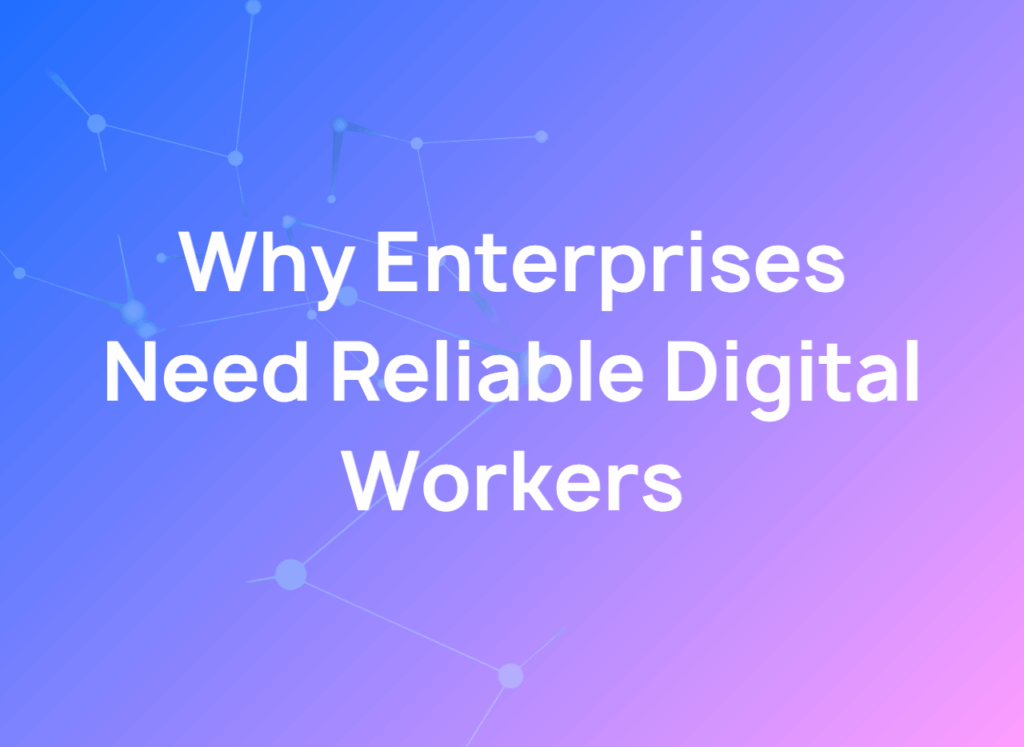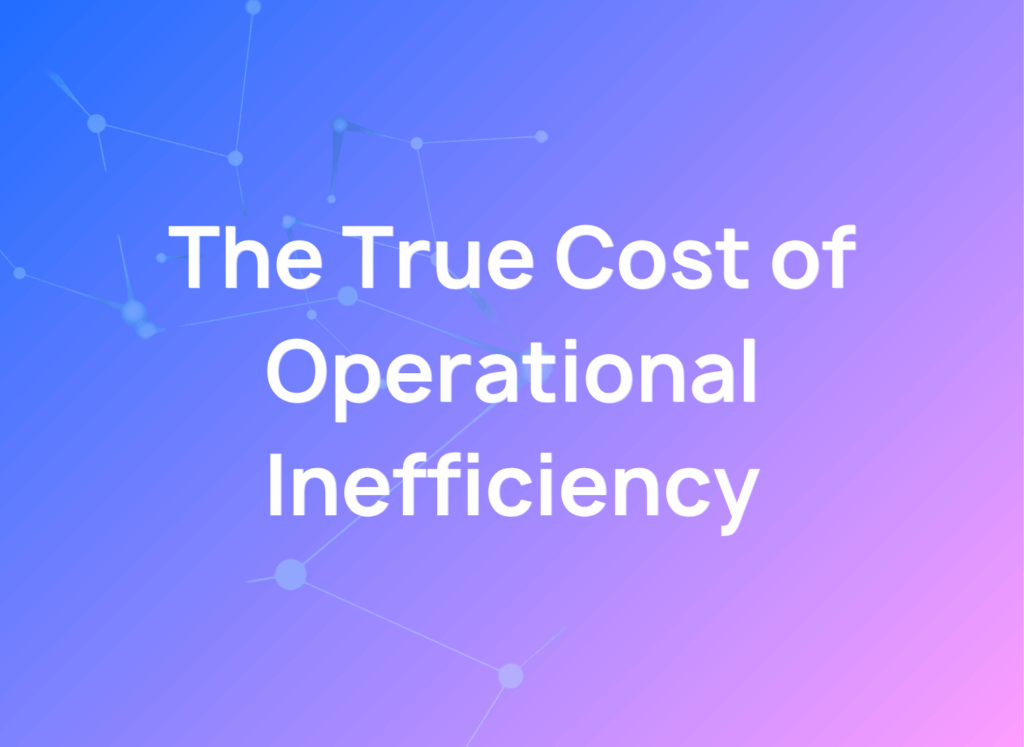Real-Time Supply Chain Visibility: The Digital Worker Revolution
Real-Time Supply Chain Visibility: The Digital Worker Revolution
Operations executives face an impossible choice: scale your team to handle growing complexity, or watch critical processes break down. But what if there was a third option—one that doesn't require hiring sprees or software sprawl?
The answer lies in Digital Labor. While traditional supply chain AI tools require constant management and integration headaches, Digital Workers operate as autonomous team members, handling everything from real-time visibility queries to complex operational workflows. They don't just analyze data—they execute decisions, adapt to changes, and deliver outcomes without human intervention.
This isn't another dashboard to monitor. It's a fundamental shift in how supply chain operations function.
The Hidden Cost of Manual Workflows
Your supply chain operations are drowning in manual tasks. Data consolidation, exception handling, supplier communications, and performance reporting consume countless hours while critical decisions wait in queue. Meanwhile, tool sprawl has created information silos that fragment visibility and drain resources.
Consider the typical supply chain query process: A sudden supplier disruption requires immediate assessment. Your team scrambles across multiple systems, manually pulls data from various sources, conducts analysis, and prepares recommendations. By the time actionable insights emerge, the disruption has already cascaded through your network.
The real problem isn't lack of data—it's the manual effort required to transform information into action.
Supply chain AI tools and operations AI tools promise solutions, but they often create new problems. More dashboards to monitor. More alerts to manage. More integration challenges that require technical expertise your team doesn't have.
Digital Workers: Beyond Traditional Automation
Digital Workers represent a paradigm shift from traditional supply chain AI tools. Instead of providing analytics platforms that require human interpretation, Digital Workers function as autonomous team members who execute complete workflows from start to finish.
A Digital Worker doesn't just identify a potential stockout—it analyzes supplier capacity, evaluates alternative sources, calculates impact scenarios, and initiates procurement processes. It operates continuously, adapting to changing conditions through causal reasoning rather than rigid rule-based automation.
These aren't tools you configure. They're outcomes we deliver.
Each Digital Worker is manufactured through causaLens' proprietary Digital Labor Factory, utilizing repeatable blueprints that accelerate deployment. They integrate seamlessly with existing systems, require no additional headcount, and scale according to operational demands.
Transforming Supply Chain Operations
Real-Time Visibility That Actually Works
Traditional supply chain visibility tools create information overload. Digital Workers deliver intelligent visibility—automatically surfacing critical insights, predicting potential disruptions, and recommending actions based on real-time conditions.
When a supplier performance deviation occurs, your Digital Worker doesn't just flag the issue. It assesses impact across all affected product lines, evaluates alternative suppliers, calculates cost implications, and provides prioritized recommendations. All while maintaining continuous monitoring for similar patterns across your entire network.
Cost Reduction Through Intelligent Automation
Manual supply chain processes consume significant resources. Digital Workers eliminate these inefficiencies by automating end-to-end workflows that traditionally require multiple team members and several days to complete.
causaLens customers typically achieve guaranteed ROI of 500% or more through reduced operational costs, eliminated consulting fees, and enhanced decision-making speed. One client reduced inventory carrying costs by $20 million within months of Digital Worker deployment.
Scalability Without Complexity
Traditional operations AI tools require extensive customization and ongoing maintenance. Digital Workers scale automatically, handling increased complexity without additional infrastructure or technical resources.
As your operations grow, Digital Workers adapt to new suppliers, products, and market conditions. They learn from patterns, adjust to changing business rules, and maintain performance without requiring constant reconfiguration.
Adaptive Intelligence for Dynamic Markets
Supply chains operate in constantly changing environments. Digital Workers leverage causal reasoning to understand cause-and-effect relationships, enabling them to adapt to new conditions rather than simply following predetermined rules.
When market conditions shift, Digital Workers automatically adjust forecasting models, rebalance inventory strategies, and modify supplier evaluation criteria. This adaptive capability ensures continued performance regardless of external changes.
Real-World Impact: Digital Workers in Action
Cisco Transforms Demand Forecasting with AI Agents
Cisco is revolutionizing demand forecasting with causaLens AI agents, scaling operations across 10,000+ products, 10 business units, and a global multi-billion-dollar supply chain. These agents act like PhD-level economists, handling complex analytics workflows, from feature engineering to model explanation, while addressing bottlenecks in data processing and decision-making.
By automating tasks and generating business-friendly insights, the agents reduce dependency on senior analysts and enhance scalability. Cisco’s approach unlocks faster model development, reusable intelligence, and trust in data-driven decisions, paving the way for a future where AI agents manage analytics workflows end-to-end.
Getting Started with Digital Labor
Implementing Digital Workers requires a strategic approach that begins with high-impact, low-risk processes before scaling to complex workflows.
Phase 1: Automate Foundational Tasks
Start with repetitive, high-effort tasks that consume significant resources. Digital Workers excel at data consolidation, exception handling, and routine reporting. These initial implementations provide immediate value while building organizational confidence.
Phase 2: Scale to Complex Workflows
Expand Digital Worker capabilities to handle complete operational workflows. This includes demand forecasting, supplier evaluation, and procurement optimization. Digital Workers manage these processes end-to-end, reducing fragile handoffs and dependencies.
Phase 3: Enable Strategic Capabilities
Leverage causal intelligence to unlock advanced capabilities like scenario planning, risk assessment, and strategic optimization. Digital Workers can simulate counterfactuals, explain performance changes, and adapt to shifting business drivers.
Implementation Approach
causaLens partners with organizations throughout the Digital Worker implementation process. We don't just provide software—we deliver custom-built Digital Workers tailored to your specific processes and systems.
Our Digital Labor Factory accelerates deployment through proven blueprints while ensuring each Digital Worker fits your unique operational requirements. Enterprise-grade security, seamless integration, and continuous optimization ensure sustainable value delivery.
The Future of Supply Chain Operations
Supply chain operations are evolving rapidly. Organizations that continue relying on manual processes and traditional tools will struggle to maintain competitive advantage. Digital Workers represent the next evolution—autonomous intelligence that handles operational complexity while enabling strategic focus.
The transformation isn't just about efficiency improvements. It's about creating operational capabilities that scale with your ambitions rather than constraining them.
Digital Workers eliminate the traditional trade-off between operational complexity and resource requirements. They provide the intelligence and execution capacity needed to optimize supply chain performance while freeing your team to focus on strategic initiatives that drive business growth.
This is Digital Labor. A new operating model for supply chain excellence.
Ready to transform your supply chain operations? causaLens Digital Workers are custom-built to handle your specific challenges and deliver guaranteed outcomes. Contact us to explore how Digital Labor can revolutionize your supply chain visibility and operational efficiency.
Ready to Transform Your Supply Chain Ops?
Custom-built Digital Workers revolutionize your supply chain visibility and operational efficiency.
Frequently Asked Questions
AI-powered Digital Workers are advanced software tools that mimic human skills to automate repetitive tasks, analyze data, and make real-time decisions. They enhance efficiency, reduce costs, and provide actionable insights to drive operations with precision.
Digital Workers use AI and real-time data analytics to provide end-to-end visibility across the supply chain. They identify bottlenecks, predict disruptions, and offer insights, enabling smarter, data-driven decisions to maintain operational flow.
Yes, AI eliminates inefficiencies by optimizing workflows, automating monotonous processes, and reducing error rates. This leads to reduced operational expenses while enhancing productivity without the need for additional hiring or complex tool integrations.
Absolutely. AI-powered supply chain solutions are designed to be highly adaptable and scalable. Whether you're managing a small-scale operation or a global supply chain, Digital Workers can be customized to meet your unique demands and goals.
The long-term advantages include sustainable operational growth, future-proofing processes, enhanced customer satisfaction through timely deliveries, and staying competitive in a fast-evolving market by leveraging cutting-edge technology.





